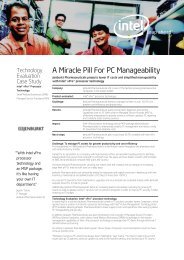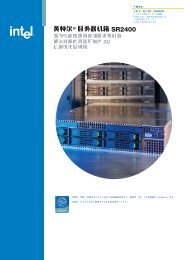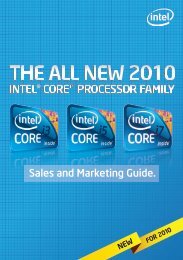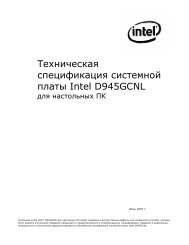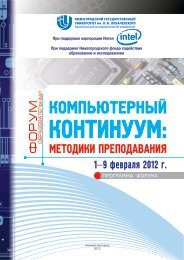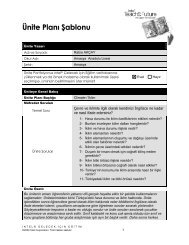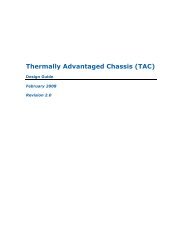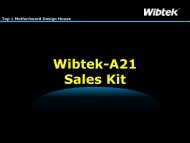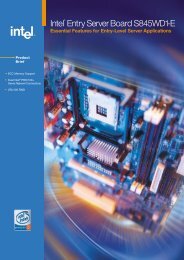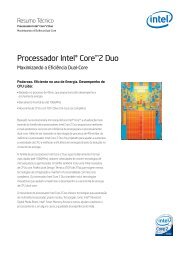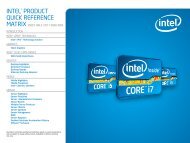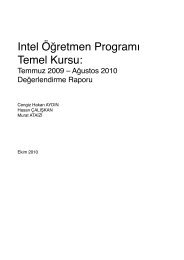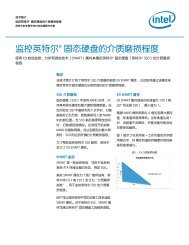Technical Product Specification for Canoe Pass - Preminary - Intel
Technical Product Specification for Canoe Pass - Preminary - Intel
Technical Product Specification for Canoe Pass - Preminary - Intel
Create successful ePaper yourself
Turn your PDF publications into a flip-book with our unique Google optimized e-Paper software.
<strong>Intel</strong> ® Server Board S2600CP and Server System P4000CP TPS Design and Environmental <strong>Specification</strong>s<br />
15. Design and Environmental <strong>Specification</strong>s<br />
15.1 <strong>Intel</strong> ® Server Board S2600CP Design <strong>Specification</strong>s<br />
Operation of the <strong>Intel</strong> ® Server Board S2600CP at conditions beyond those shown in the<br />
following table may cause permanent damage to the system. Exposure to absolute maximum<br />
rating conditions <strong>for</strong> extended periods may affect system reliability.<br />
Note:<br />
Table 151. Server Board Design <strong>Specification</strong>s<br />
Operating Temperature 0º C to 55º C 1 (32º F to 131º F)<br />
Non-Operating Temperature<br />
-40º C to 70º C (-40º F to 158º F)<br />
DC Voltage<br />
± 5% of all nominal voltages<br />
Shock (Unpackaged)<br />
Trapezoidal, 50 G, 170 inches/sec<br />
Shock (Packaged)<br />
< 20 pounds<br />
20 to < 40 pounds<br />
40 to < 80 pounds<br />
80 to < 100 pounds<br />
100 to < 120 pounds<br />
120 pounds<br />
Vibration (Unpackaged)<br />
Revision 0.8 <strong>Intel</strong> Confidential<br />
<strong>Intel</strong> order number G26942-003<br />
36 inches<br />
30 inches<br />
24 inches<br />
18 inches<br />
12 inches<br />
9 inches<br />
5 Hz to 500 Hz 3.13 g RMS random<br />
1 Chassis design must provide proper airflow to avoid exceeding the processor maximum case temperature.<br />
Disclaimer Note: <strong>Intel</strong> Corporation server boards contain a number of high-density VLSI and<br />
power delivery components that need adequate airflow to cool. <strong>Intel</strong> ensures through its own<br />
chassis development and testing that when <strong>Intel</strong> ® server building blocks are used together, the<br />
fully integrated system will meet the intended thermal requirements of these components. It is<br />
the responsibility of the system integrator who chooses not to use <strong>Intel</strong> ® developed server<br />
building blocks to consult vendor datasheets and operating parameters to determine the amount<br />
of airflow required <strong>for</strong> their specific application and environmental conditions. <strong>Intel</strong> Corporation<br />
cannot be held responsible, if components fail or the server board does not operate correctly<br />
when used outside any of its published operating or non-operating limits.<br />
15.2 <strong>Intel</strong> ® Server System P4000CP Environmental Limits (subject to change)<br />
The following table defines the system level operating and non-operating environmental limits.<br />
Temperature<br />
Humidity<br />
Shock<br />
Table 152. System Environmental Limits Summary<br />
Parameter Limits<br />
Operating 10º C to 35º C (50º F to 95º F) with the maximum rate of change not to exceed<br />
10°C per hour<br />
Non-Operating -40º C to 70º C (-40º F to 158º F)<br />
Non-Operating 50% to 90%, non-condensing with a maximum wet bulb of 28° C (at temperatures<br />
from 25° C to 35° C)<br />
Operating Half sine, 2g, 11 mSec<br />
155



